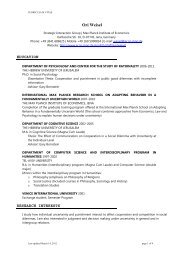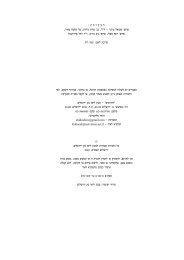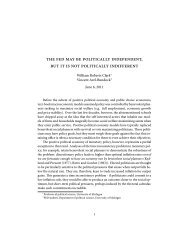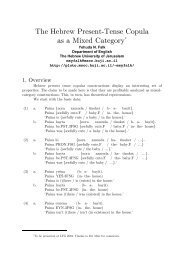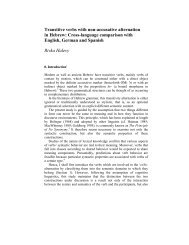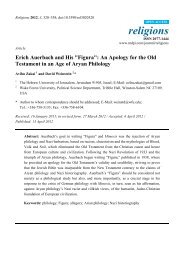View - Pluto Huji Ac Il
View - Pluto Huji Ac Il
View - Pluto Huji Ac Il
You also want an ePaper? Increase the reach of your titles
YUMPU automatically turns print PDFs into web optimized ePapers that Google loves.
α = 0.05, for example, it can be loosely interpreted as a rule that in the long run allows<br />
5% of all intervals, published or not, to miss the target parameters. Thus, the company<br />
uses a criterion that concerns all intervals, but discloses only selected ones.<br />
The regulator is aware only of the experiments that are published, namely, the successful<br />
ones, and suggests the criterion<br />
Pθ(CI(XTj ) ∋ θTj ) ≥ 1 − α for all θ ∈ (0, 1)∞ , (5)<br />
that takes into account the distribution of the observations XTj . The regulator’s view is<br />
that the confidence intervals must reflect the selection made by the company.<br />
The conflict becomes very apparent if one imagines a dishonest company that repeats the<br />
same experiment with the very same dose (and hence the same θ) until a success (X ≤ 1)<br />
is obtained, and calculates confidence intervals ignoring the fact that the probability θ<br />
is the same in all experiments. For example, suppose that the true probability of a toxic<br />
reaction is θ = 0.25 so that the number of toxic cases follows a Bin(20, 0.25) law. Under this<br />
model, the probability of a successful experiment is 0.7520 + 20 × 0.25 × 0.7519 ≈ 0.0243,<br />
so that on average, for every 40 experiments performed, the company will achieve one<br />
successful experiment and publish its corresponding confidence interval. This published<br />
interval includes only θ values below 0.25 as we saw above.<br />
3 A BAYESIAN PERSPECTIVE<br />
Failing to agree on a frequentist confidence measure, the company and the regulator may<br />
consult the Bayesian school. The two sides of the conflict hope for a useful advice from a<br />
Bayesian, knowing that Bayesians, unlike frequentists, analyze the observed data regardless<br />
of the design (see Ferguson 1967 Chapter 7.2, and Berger 1985 Chapter 7.7 for a comprehensive<br />
discussion). A relevant example in our context is the Stopping Rule Principle in<br />
sequential analysis: the stopping rule [terminating the data collection] should have no effect<br />
on the final reported evidence about θ obtained from the data (Berger 1985 p. 502). This<br />
principle is espoused by Bayesians, but not necessarily by frequentists. A simple instance<br />
would be a sequence of N Bernoulli experiments which ends with one failure (see Lindley<br />
and Phillips 1976 for a similar example). A frequentist must know the experimental design:<br />
was N fixed in advance, or is it a Geometric random variable, whereas in Bayesian analysis<br />
the nature of N turns out to have no effect on the calculations.<br />
Returning to the sequence of toxicity experiments, let X denote the whole data and let<br />
Tj(x) = t be the index of the j-th successful experiment. For any prior Π of the sequence<br />
θ, it is easy to see that the posterior distribution of θTj |X = x is equal to the posterior of<br />
θt|X = x, and as above, the reason for stopping is irrelevant. Therefore, if the regulator and<br />
the company were to use the same data and agree on the prior model, then their inference<br />
for θTj<br />
would be the same in spite of the selection.<br />
However, in the situation considered here, the regulator and the company do not have<br />
the same data, hence their inferences may be different as they condition on different events.<br />
Indeed, here the regulator observes Xt only for those t such that Tj = t, whereas the<br />
company has the values of Xi for all i. Thus, the company should base its inference on<br />
θt|X = x, while the regulator should base his inference on θt|{XT1, XT2, . . .} .<br />
In what follows, we consider two extreme models for the joint distribution of θ, a<br />
model of independence and a model of strong dependence, in order to demonstrate how the<br />
4



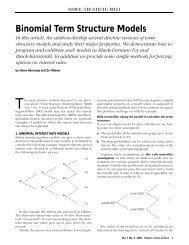
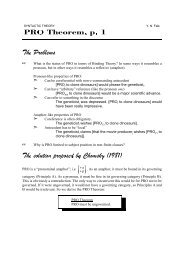
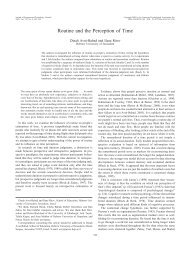
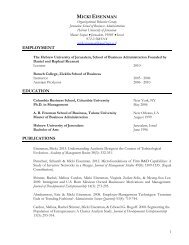
![CV [PDF] - Pluto Huji Ac Il](https://img.yumpu.com/18174585/1/190x245/cv-pdf-pluto-huji-ac-il.jpg?quality=85)
